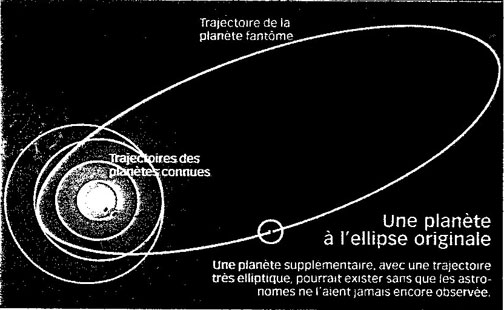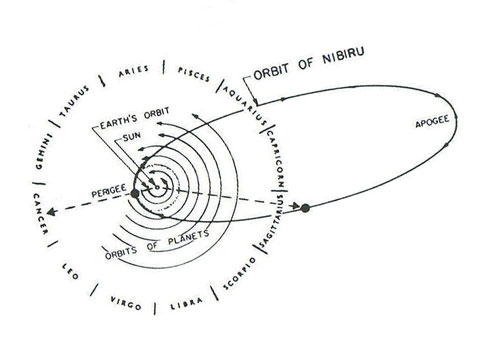|
On The Trail of “Planet X” THE CASE OF THE FRENCH ASTRONOMER In ancient Sumer the highlight of the New Year celebration was the public reading of Enuma Elish, the “Epic of Creation.” Scholars have treated the long text (inscribed on seven clay tablets) as an allegory of a struggle between good and evil, between a benevolent celestial god and a celestial monster. In my books I treated the ancient text as a sophisticated scientific cosmogony about the formation of our solar system, and a celestial collision in which a planet called “Tiamat” was destroyed by the invading planet “Nibiru,” bringing about the Earth and the Moon. Nibiru (renamed “Marduk” by the Babylonians) itself was caught into permanent elongated orbit around the Sun, becoming the twelfth member of our Solar System (the Sumerians counted the Sun, the Moon, and – with Nibiru – ten planets). The Unavoidable Collision Many astronomers and astrophysicists, struggling to explain the Asteroid Belt (between Mars and Jupiter) and the origin of our Moon, find it unavoidable to include a celestial collision in their explanatory theories. The British weekly New Scientist devoted the cover of a recent issue to “The Planet That Stalked the Earth.” The long lead article offers theories about a “rogue planet” involved in the collision. What I found most fascinating in the article’s suggestions is its calling the enigmatic planet THEIA – without explaining why. Was someone thinking of Tiamat? A ‘Phantom Planet’ Last year, in France, a pending discovery –- an astounding discovery – was announced in the pages of the prestigious monthly Science & Vie (“Science and Life”). In its issue of February 2003 it published an update on the planetary makeup of our Solar System in light of recent discoveries in the “Kuiper Belt” (a zone on the Solar System’s fringes). Titled “PLANETS – But How Many Are There In Our Solar System?” the long article, by the journal’s Valerie Greffos, made a sensational announcement: there is one more, unknown, planet in our Solar System – “A
‘PHANTOM PLANET’ WHOSE POSSIBLE The assertion was based on statements made to the journal by Alessandro Morbidelli, an astronomer at France’s observatory at Côte d’Azur. The Solar System, he explained, was chaotic in the beginning. There was a celestial collision involving a “supplementary planet” that had existed where the Asteroid Belt is now. It happened about 3.9 billion years ago; and those events explain the unusual long elliptical orbit of the “Phantom Planet.” “I expect that one day we will discover a new, Mars-sized planet!” he told the journal with certainty, a planet whose orbital period is “several thousand years.” He provided the journal with a sketch of the planet’s elongated elliptical orbit and even indicated in the sketch where the “Phantom Planet” is probably now:
“It’s Sitchin’s Drawing!” The article in Science & Vie, with its sensational statements by the French astronomer, was brought to my attention (regrettably belatedly) by a fan in France, who could not resist writing on the photocopy, above the sketch: “It’s Sitchin’s drawing!” Now, were the French astronomer merely suggesting the existence of one more large planet far out from the Sun, his announcement would have been just one more addition to the decades-long discussions by astronomers regarding a “planet X” beyond Uranus, Neptune and Pluto. I, for one, would have welcomed such an additional affirmation, especially from a French observatory known for its interest in the subject. But the statements by this astronomer went well beyond a mere suggestion of one more planet; he added details that could have come only from reading my books, especially The 12th Planet (1976) and Genesis Revisited (1990) concerning NIBIRU, the home planet of the Anunnaki “gods” of the Sumerians: * At the beginning the Solar System was “chaotic” (my exact words); * There had been a “supplementary planet” where the Asteroid Belt is now (= Tiamat of the Sumerian texts); * A celestial collision ‘rearranged’ the Solar System (the essence of Enuma Elish if treated as a cosmogony); * Based on findings on the Moon, the collision occurred circa 3.9 billions years ago (my exact conclusion); * In the aftermath of the collision, the Solar System acquired the “Phantom Planet” (= Nibiru/Marduk); * Its orbit is elliptical and not circular (a major aspect of my conclusions); * At its perigee (closest to the Sun) it passes between Jupiter and Mars (a key unorthodox conclusion in my writings); * The orbit lasts thousands of (Earth-) years (I applied to it the Sumerian Sar = 3,600). Moreover, the sketch that Alessandro Morbidelli provided to the French journal is not just similar to sketches in my books of Nibiru’s orbit, but is exactly a copy of the sketch in Genesis Revisited (Fig. 107) where I indicated Nibiru’s probable position now:
So What Did They Have To Say? My French fan (himself an author of books on UFO’s) lost no time writing Alessandro Morbidelli at the Côte d’Azur observatory, pointing out the similarity. But months passed without a response. He has also written to Science & Vie; but never received an answer… I asked my editor at Edition Carnot in Paris, who was preparing a French translation of Genesis Revisited, to take up the issue with Science & Vie. “I think that an intervention would be more powerful if it comes not from someone in New York but from a respected French publisher, like Carnot,” I wrote to him (oh so naively…). I finally heard from him of the results of his ‘intervention’: “I talked to the author of the S&V article, Mrs. Valerie Greffos. She told me she doubted Alessandro Morbidelli could have been inspired by your books.” Just like that! He gave me S&V’s phone numbers, saying it would be useless to try to write to them. So I never did. And to this day I wonder: Should I be pleased that a respected astronomer at a leading French observatory adopted my conclusions regarding Nibiru and the Sumerian cosmogony –- or should I be upset that my life’s work was “appropriated” without any acknowledgement and credit to me? |
||
| © Z Sitchin 2004 |
ZECHARIA SITCHIN |
|
|
||

